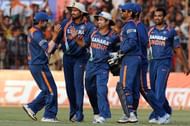Nail-biting matches have become part and parcel of cricket, especially with the advent of T20s. The adrenaline rush that the fans go through during such thrillers is beyond description, and sometimes seems on par with that of the players in the park out there.
Some of the innings played and spells bowled under a great deal of pressure to get their team over the line are unforgettable. And the thing about 1-run losses is that they don't diminish the grit, determination and skill displayed by either team.
High-scoring thrillers have been more common in today's era, but low-scoring thrillers are the ones which captivate the fans more. Here, we look at some of the closest shaves in one-day cricket till date (ties have been excluded).
6. India vs Australia, 5th ODI at Hyderabad, 5th November 2009

This was a one-day series between India and the then no. 1 ranked one-day side Australia, who had won the Champions Trophy 2009 a month ago. The seven-match series was locked at 2-2 with three more games to play.
Australia had piled on a formidable score of 350, with Shaun Marsh leading the way by scoring a century. Shane Watson's 93, a run-a-ball 45 by Ricky Ponting and a quick-fire partnership between Cameron White and Michael Hussey propelled them to a total which eventually proved to be marginally enough.
Virender Sehwag and Sachin Tendulkar got India off to a blistering start and raced away to a partnership of 66 in less than nine overs. Tendulkar had been the pillar of the batting amid the wobbling middle order of Gautam Gambhir, Yuvraj Singh and Mahendra Singh Dhoni. Suresh Raina hung around to revive the innings, building a partnership of 137 with Tendulkar.
After Raina fell, Jadeja struck three boundaries in quick succession to give India an upper hand. With just 19 required off the last three overs Tendulkar played a reverse sweep off Clint McKay only to get caught, in the process effectively ending India's hopes.
India eventually got bowled out for 347, falling three runs short of Australia's target.
5. India vs Sri Lanka, 1st ODI at Rajkot, 15th December 2009

After the Test series had ended in a humbling fashion for Sri Lanka, the two sides locked horns in the limited overs series. Virender Sehwag, who was in sparkling form in the Test series, took off from where he left.
Batting first, Tendulkar and Sehwag piled on 150 inside 20 overs. With plenty of batting still to come, a big first innings total was on the cards.
Mahendra Singh Dhoni promoted himself to further accelerate the pace, and he did just that by scoring 72 off just 53 deliveries. Plenty of cameos by the middle-order batsmen carried India to a massive total of 414. Sehwag spearheaded the batting for India by scoring 146 off just 102 balls.
Dilshan and Tharanga kept Sri Lanka neck to neck in the pursuit of this big target. They put on nearly 200 for the first wicket before part-time bowler Suresh Raina provided India the wicket of Tharanga.
Skipper Sangakkara joined the centurion Dilshan at No. 3 and put on yet another big stand. He blazed away to 90 off just 43 balls, sharing a partnership of 128 runs with Dilshan.
But Sangakkara pulled one to deep square leg and was dismissed for 90, which was the turning point of the match.
Dilshan was still going strong, but the inability of the middle-order batsmen to put their hands up enhanced the pressure on the opener. Dilshan was bowled by Harbhajan Singh for a splendid innings of 160.
Thilina Kandamby and Angelo Matthews kept the runs coming but the boundaries had dried up. Sri Lanka kept losing wickets under pressure, trying to hit big.
In spite of a phenomenal effort in the run-chase, Sri Lanka ended up on 411, four runs short of pulling off a heist.
4. India vs South Africa, Johannesburg, 15 January 2011

India were humbled in the first One-day international by 135 runs, courtesy of a clinical South African bowling display. The Proteas had looked set on winning the second one-day international as well as they produced the goods through another flawless bowling performance.
Batting first, India were blown away for 189 runs. Yuvraj Singh was the lone warrior and scored the only half-century in yet another disappointing outing by India. Mahendra Singh Dhoni chipped in with a useful 38, but no other batsman could stand the pace of Tsotsobe and Morkel.
South Africa's history then came back to haunt them all over again. Graeme Smith, the skipper, led the way with a brave innings of 77. Colin Ingram and David Miller chipped in with vital contributions too, but the other batsmen threw their wickets away in pursuit of a paltry target.
In the 33rd over of the South African innings, Munaf Patel bagged two wickets to trigger a collapse. South Africa's last wicket, Wayne Parnell, fell with South African needing one run with seven overs left.
The hosts made a mess of what should have been a comfortable chase, stumbling in the batting powerplay and sinking to a disheartening defeat.
3. Australia vs South Africa, 5th ODI at Wanderers, 12 March 2006

On 12th March 2006, one of the greatest one-day internationals of all time was played between two of the most fearsome sides ever seen. The match yielded an aggregate of 872 runs with 13 wickets.
Australia, led by skipper Ricky Ponting's century and three half-centuries from Gilchrist, Katich and Hussey, combined with a quick cameo by Symonds, put on a mammoth 434 from their fifty overs. That score was the highest ever in fifty-over cricket, but only till the second innings was done.
South Africa lost Dippenaar in the second over itself, which suggested South Africa would meekly surrender in this mighty chase. But Graeme Smith and Herschelle Gibbs roared back with a sizzling partnership of 187, putting their team well within sight of overriding Australia's score.
Smith was sent back to the pavilion but Gibbs stuck around despite wickets falling all around him. He shared strong partnerships with Kallis and De Villiers to get his team closer.
Once Gibbs perished, Mark Boucher held the innings together and Johan van der Wath provided the pyrotechnics. Boucher held his nerve and hit a boundary on the second last ball to achieve the unthinkable.
By hitting the boundary, Boucher reached his half-century off 43 deliveries, with the scorecard reading 438-9.
Nathan Bracken took five wickets for 67 runs, which went in vain. Mick Lewis created an unwanted record of conceding the most runs by a bowler in one-day cricket. Both Gibbs and Ponting were awarded the Man of the Match, but Ponting declined it, saying that it belonged to Gibbs.
2. Australia vs South Africa at Edgbaston, World Cup semifinal, 17 June 1999

The semifinal of the 1999 World Cup was perhaps the most heart-breaking moment ever for South Africa and Lance Klusener.
Australia were triumphant in the Super Six match of the tournament against the same side after Herschelle Gibbs dropped a sitter off Steve Waugh's bat. This meant that in the event of a tie in the semifinal, Australia would go through.
Australia put up a meager 213 batting first, with Shaun Pollock and Allan Donald displaying some top-class bowling. Half centuries from Michael Bevan and Steve Waugh followed by Ponting's invaluable contribution gave the Australian bowlers something to bowl at.
In reply, Gary Kirsten and Herschelle Gibbs put on an opening partnership of 48 in 12 overs. But it was the 13th over of the innings that started putting South Africa on the backseat.
Three wickets by Shane Warne and a run-out effected by Bevan reduced South Africa to 61-4. Jonty Rhodes and Jacques Kallis then steered South Africa ahead with a partnership of 84, before a flurry of wickets pegged them back again.
By the time the match was down to the last over, South Africa needed just nine runs to win with one wicket in hand. Lance Klusener, who was in roaring form throughout the tournament, was at the crease with Allan Donald at the non-striker's end.
Klusener blasted two boundaries off the first two balls, bringing the equation down to 1 off 4 deliveries. With the fielders up to save the single, Klusener mis-hit the third delivery, only for Lehmann to miss the stumps by half an inch. The fourth ball of the over brought the curtains down for South Africa in the World Cup.
With South Africa still needing a run, Klusener mis-hit the ball and started sprinting down the pitch, but Donald remained unmoved at the non-striker's end. Damien Fleming, the bowler, rolled the ball to Gilchrist to complete the run-out and secure a tie.
Australia progressed to the final and went on to beat Pakistan to lift the World Cup.
1. India vs Pakistan at Sharjah, Austral-Asia Cup final, 18 April 1986

The final of the Austral-Asia Cup 1986 was the much-anticipated match between India and Pakistan, and it had a cracking start.
Kris Srikkanth and Sunil Gavaskar put on over a hundred for the opening stand and set the tone to hand Pakistan a daunting total. Dilip Vengsarkar's handy half-century almost built another century partnership for India after Srikkanth departed.
The magical Wasim Akram and captain Imran Khan sparked Pakistan's comeback by picking up wickets at crucial junctures. They ended up restricting India to just 245 from what looked like a total of an excess of 270 a few overs back.
Akram collected three wickets and Imran chipped in with two scalps in a tremendous bowling performance.
Pakistan had a sluggish start to their innings, losing three wickets for a little more than fifty runs. However, with Pakistan's greatest batsman Javed Miandad at the crease, the game was far from over.
Saleem Malik, Abdul Qadir and Mohsin Khan couldn't quite make big scores but ably supported Miandad by building invaluable partnerships, dragging Pakistan's score forward.
After the 71-run stand between Qadir and Miandad, quick wickets dented Pakistan's progress yet again. With just the tail for company, it looked like a steep task for Miandad to get the team over the line.
Pakistan still clung on pretty well, and eventually, it was down to 11 runs off the final over.
Chetan Sharma was entrusted with the job of bowling the final over to defend 11 runs. However, he leaked seven runs off five balls, with a boundary required off the final ball.
Sharma missed the yorker by a few inches and Miandad heaved it for six over mid-wicket. A last ball six against a bitter rival - that's as sensational as it gets, and Miandad became a national hero.
Looking for fast live cricket scores? Download CricRocket and get fast score updates, top-notch commentary in-depth match stats & much more! 🚀☄️
